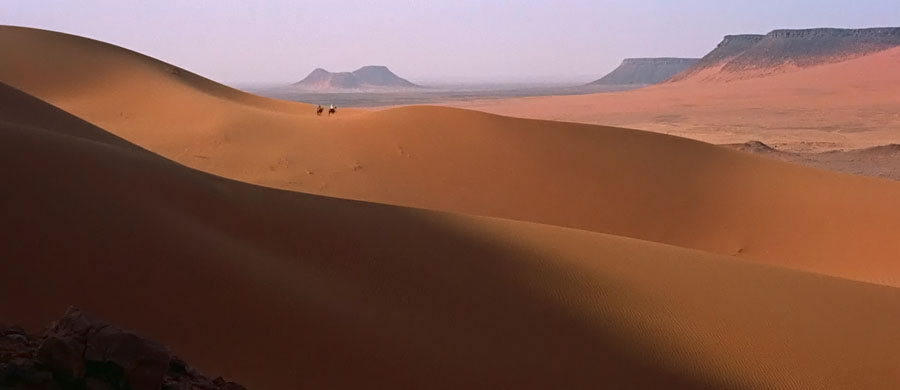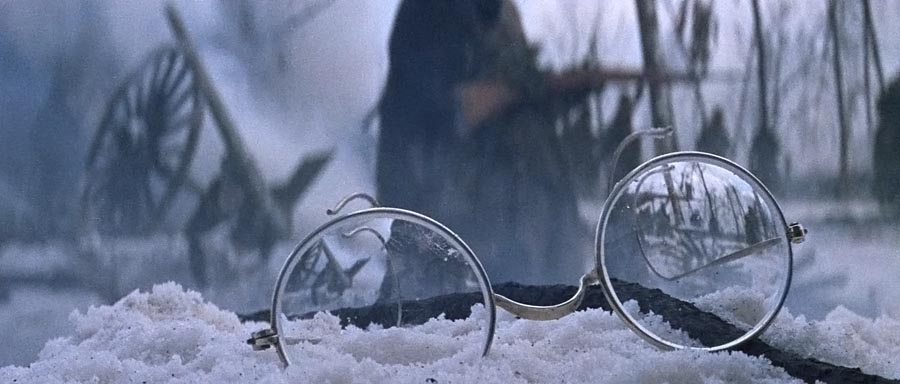#11. After I moved from the Mojave Desert to the forests of Virginia, I was often homesick for those open spaces of the West. So it’s probably no surprise that I was so enthralled with “Lawrence of Arabia” when I finally saw it in college at U.Va. I loved the precision of David Lean’s (and Anne Coates’) editing, his well-designed scene transitions, and of course Freddie Young’s 65mm landscape cinematography. All of this was doubly-reinforced when Robert Harris released his restoration in 1989 while I was at graduate film school – up until then, I had only seen the movie in beat-up 35mm scope prints. Even today, I get goosebumps in the early scenes of Lawrence and his guide crossing the Jordanian desert, accompanied by Jarre’s romantic score. I saw a lot of Lean’s other movies during the 1980’s; the intelligence behind his directorial choices is always so evident and even today, I learn something new every time I see one of his movies. His earlier b&w movies are also wonderful. Surprisingly, American Cinematographer never really ran an article in 1962 about the cinematography of LOA, even after it had won the Oscar. Freddie Young did write a cinematography textbook that gives you some clues as to his working methods, and various Lean biographies and books on the production have filled in many details. The movie isn’t so much about stylistic photographic tricks as it is about highly-refined visual taste combined with immense physical effort and willpower. Lean was about 52 when he began production and Young was 58; when I was a college student, that seemed amazing… but now that I am 53, that doesn’t seem old to me…

There was a documentary I saw years ago about David Lean working with Robert Bolt on their final screenplay, “Nostromo”. It was fascinating how Lean was so attuned to the smallest of details, like when a character gets shot and falls to the floor in a hotel, Lean wanted to make sure he wasn’t carrying a suitcase because the image and sound of a body and an object hitting the floor was less strong than just the body. In that documentary, Spielberg mentions the use of strong sound transitions in “Doctor Zhivago”, like the squeak of a glass slide in a laboratory being tossed into a dish transitioning to the squeal & hiss of a trolley car leaving its stop. I’ve always liked the end of the WW1 winter battle where an explosion goes off ahead of charging Tom Courtenay and Lean cuts to his spectacles hitting the snow, with the battle raging out of focus in the background. Also, the sound of Bill Sikes’ dog frantic scratching at the door to get out of the room while Sikes, off-camera, murders Nancy in “Oliver Twist”. Take a look if you haven’t seen that movie.

I cut together some scenes in "Lawrence" and "Zhivago" to demonstrate Lean's transitions between scenes, often for ironic effect:
- aces.png
- aces.png
- aces.png
- aces.png
- 24-7.jpg
- 24-7.jpg
- arri.png
- arri.png
- BandH.jpg
- camalot.png
- camalot.png
- dedo.png
- dsc.png
- dsc.png
- kino.png
- Hawk.png
- JustCinemaGear.jpg
- Leitz_logo.png
- Leitz_logo.png
- Lowing.gif
- Module8Logo.png
- GodoxLogo.png
- Nanlux.png
- NPV_new_logo-(3)-(002).png
- NMBLogoForCML.png
- lindseyo.jpg
- Aputure.png
- TC Logo Centered K_2.png
- VMI.png
- zeiss-logo.png
- zeiss-logo.png
- aces.png
- aces.png
- aces.png
- aces.png
- 24-7.jpg
- 24-7.jpg
- arri.png
- arri.png
- BandH.jpg
- camalot.png
- camalot.png
- dedo.png
- dsc.png
- dsc.png
- FUJINON.jpg
- JustCinemaGear.jpg
- Leitz_logo.png
- Leitz_logo.png
- GodoxLogo.png
- Nanlux.png
- NPV_new_logo-(3)-(002).png
- NMBLogoForCML.png
- FilmLightLogo.png
- theKeep.png
- NewLifeCineLogo.png
- PostWorks.png
- Aputure.png
- TCS.png
- TC Logo Centered K_2.png
- zeiss-logo.png
- zeiss-logo.png
- aces.png
- aces.png
- aces.png
- aces.png
- 24-7.jpg
- 24-7.jpg
- arri.png
- arri.png
- BandH.jpg
- camalot.png
- camalot.png
- dedo.png
- dsc.png
- dsc.png
- kino.png
- Hawk.png
- JustCinemaGear.jpg
- Leitz_logo.png
- Leitz_logo.png
- Lowing.gif
- Module8Logo.png
- GodoxLogo.png
- Nanlux.png
- NPV_new_logo-(3)-(002).png
- NMBLogoForCML.png
- lindseyo.jpg
- Aputure.png
- TC Logo Centered K_2.png
- VMI.png
- zeiss-logo.png
- zeiss-logo.png
- aces.png
- aces.png
- aces.png
- aces.png
- 24-7.jpg
- 24-7.jpg
- arri.png
- arri.png
- BandH.jpg
- camalot.png
- camalot.png
- dedo.png
- dsc.png
- dsc.png
- FUJINON.jpg
- JustCinemaGear.jpg
- Leitz_logo.png
- Leitz_logo.png
- GodoxLogo.png
- Nanlux.png
- NPV_new_logo-(3)-(002).png
- NMBLogoForCML.png
- FilmLightLogo.png
- theKeep.png
- NewLifeCineLogo.png
- PostWorks.png
- Aputure.png
- TCS.png
- TC Logo Centered K_2.png
- zeiss-logo.png
- zeiss-logo.png
- aces.png
- aces.png
- aces.png
- aces.png
- 24-7.jpg
- 24-7.jpg
- arri.png
- arri.png
- BandH.jpg
- camalot.png
- camalot.png
- dedo.png
- dsc.png
- dsc.png
- kino.png
- Hawk.png
- JustCinemaGear.jpg
- Leitz_logo.png
- Leitz_logo.png
- Lowing.gif
- Module8Logo.png
- GodoxLogo.png
- Nanlux.png
- NPV_new_logo-(3)-(002).png
- NMBLogoForCML.png
- lindseyo.jpg
- Aputure.png
- TC Logo Centered K_2.png
- VMI.png
- zeiss-logo.png
- zeiss-logo.png
- aces.png
- aces.png
- aces.png
- aces.png
- 24-7.jpg
- 24-7.jpg
- arri.png
- arri.png
- BandH.jpg
- camalot.png
- camalot.png
- dedo.png
- dsc.png
- dsc.png
- FUJINON.jpg
- JustCinemaGear.jpg
- Leitz_logo.png
- Leitz_logo.png
- GodoxLogo.png
- Nanlux.png
- NPV_new_logo-(3)-(002).png
- NMBLogoForCML.png
- FilmLightLogo.png
- theKeep.png
- NewLifeCineLogo.png
- PostWorks.png
- Aputure.png
- TCS.png
- TC Logo Centered K_2.png
- zeiss-logo.png
- zeiss-logo.png
- aces.png
- aces.png
- aces.png
- aces.png
- 24-7.jpg
- 24-7.jpg
- arri.png
- arri.png
- BandH.jpg
- camalot.png
- camalot.png
- dedo.png
- dsc.png
- dsc.png
- kino.png
- Hawk.png
- JustCinemaGear.jpg
- Leitz_logo.png
- Leitz_logo.png
- Lowing.gif
- Module8Logo.png
- GodoxLogo.png
- Nanlux.png
- NPV_new_logo-(3)-(002).png
- NMBLogoForCML.png
- lindseyo.jpg
- Aputure.png
- TC Logo Centered K_2.png
- VMI.png
- zeiss-logo.png
- zeiss-logo.png
- aces.png
- aces.png
- aces.png
- aces.png
- 24-7.jpg
- 24-7.jpg
- arri.png
- arri.png
- BandH.jpg
- camalot.png
- camalot.png
- dedo.png
- dsc.png
- dsc.png
- FUJINON.jpg
- JustCinemaGear.jpg
- Leitz_logo.png
- Leitz_logo.png
- GodoxLogo.png
- Nanlux.png
- NPV_new_logo-(3)-(002).png
- NMBLogoForCML.png
- FilmLightLogo.png
- theKeep.png
- NewLifeCineLogo.png
- PostWorks.png
- Aputure.png
- TCS.png
- TC Logo Centered K_2.png
- zeiss-logo.png
- zeiss-logo.png


